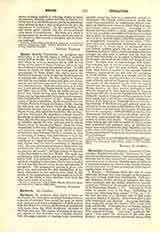

Enciso, MARTIN FERNANDEZ DE, navigator and geographer, b. at Seville, Spain, c. 1470; d. probably about 1528 at Seville. It is not known when, why, or with whom he went to America, but in 1508 he was living on the island of Santo Domingo, where he had accumulated a fortune in the practice of law. In 1509 Alonzo de Ojeda (or Hojeda) had been granted the government of Terra Firme (the region about the Isthmus of Darien), but he lacked the funds necessary to colonize the country. He then applied to Enciso, who had the reputation of being rich, able, and adventurous, and the latter agreed to provide a vessel with men and provisions. Ojeda set out in advance in 1509, and it was agreed that Enciso was to equip his vessel and follow him in 1510. When the latter arrived, he found that Ojeda, having been beset by hostile Indians, and having exhausted his supplies and ammunition, had returned in search of him. Taking the survivors of Ojeda’s expedition, Enciso founded the town of Santa Maria la Antigua del Darien (1510). Among his followers was one Vasco Nunez de Balboa who afterwards became famous for his discovery of the Pacific Ocean, then called the South Sea (Mar del Sur), and who had joined the expedition without Enciso’s knowledge or authority, seeking to escape his creditors. Soon after the founding of the new city, Balboa stirred up rebellion among the men, and was able to depose Enciso, whom he banished to Spain. Here, the latter complained to the king of Balboa’s arbitrary conduct and injustice, and the king, partly owing to these accusations, sent Pedrarias Davila to America in 1514 as Governor of Darien, with instructions to have the wrongs of Enciso righted. Enciso accompanied the expedition as “alguacil mayor” and continued to oppose Balboa until the latter’s execution by Davila in 1517. He soon afterwards returned to Spain where he published his “Suma de Geografia que trata de todas las partidas del mundo”, the first account in Spanish of the discoveries in the New World. The work was published in 1519 at Seville and was reprinted in 1530 and in 1549. It is dedicated to the Emperor Charles V, and in it, according to Navarrete, Enciso has embodied all that was then known of the theory and practice of navigation. The geographical portion is given with great care, and contains the first descriptions of the lands discovered in the western seas, that is, the results of the explorations of the Spaniards up to 1519. It is, on the whole, a more accurate work than the other early works of its kind.
VENTURA FUENTES

